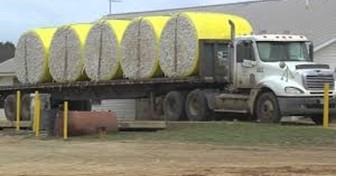There are a couple of caution flags, however. The October USDA estimate for World Use was reduced 740,000 bales from the September estimate. This is the first time for the 2021 crop year that the monthly estimate has not been higher than the previous month. Does this signal some weakening in demand? I hope not, but it’s something to keep an eye on.
The optimism for demand growth needs to be validated by strong weekly export sales and shipments. Weekly reports can be highly variable. But, that’s expected and the market will react accordingly. China is expected to be a big buyer and, so far, has been. USDA’s October estimates increased China imports by ½ million bales. So far, sales to China total 2.18 million bales—27% of our total exports and a market share of 21% of the total that China is expected to import. Total sales to all destinations currently total 8.1 million bales compared to 8 ½ million bales at this time last year. While that’s lower, if shipments are also on that same pace, that will reach USDA’s projection for 2021 crop year exports. We need to keep an eye on the pace of shipments.
USDA’s October estimates reduced the US crop by a ½ million bales. The crop could get smaller. There are also questions about China and India. The October estimates trimmed the India crop by ½ million bales but left the China crop unchanged. This has added some support for price.

Dec21 futures is currently (as of 10/19/2021) almost $1.08. New crop Dec22 futures is almost $0.91. Where does price go from here? Could prices move even higher? Yes. I can build scenarios for that. Could prices weaken? Yes. I can build scenarios for that too.
Nobody knows where this is headed. Factors impacting price include supply and demand, weekly exports, the grain and soybean markets, and the value of the dollar. All we know is that when cotton goes above $1.00, historically it doesn’t stay there long. But, we are in an unusual year.
We also need to be aware of another factor contributing to the run-up in prices and that is “speculative interests”. What does that mean? The simplest way to explain—these are buyers and sellers of futures contracts but are not buyers or sellers of the physical commodity. They are neither producers or users. They are not part of the supply chain. They are only in the market seeking potential profit. When this happens, prices can be fickle. When the speculative interests decide to take their profit and exit, prices will fall if there’s not solid supply and demand fundamentals behind the price level. Eventually, as always, supply/demand fundamentals will guide the price discovery process.
Looking at the fundamentals as we think we know them today, even if prices weaken, the market should have good support at 90 to 95 old crop and 80 to 85 new crop. On the other hand, the right fundamentals could push price higher and fuel even more speculative optimism.
As I said, we are in a very unusual year. Growers need to be or should be thinking about adding to 2021 crop sales and even looking ahead to the 2022 crop. But, this is the busiest time of the year for growers with both peanuts and cotton. Growers are running wide open focused on harvest. Also, typically this is not a time of the year when prices are high, so producers aren’t thinking about marketing—but this year is different. My fear is that once the dust settles and farmers have time to refocus on marketing, I hope they have not missed an opportunity at some of the better prices for this next year’s crops.
Also, there is some uncertainty about how good the crop is and growers may feel hesitant to yet price more of this years crop—depending on how much is already committed. But, we’re quickly approaching a point where the farmer will know if they have 800-lb cotton or 1,500-lb cotton. This will aid in knowing how many bales remain uncommitted and in making market decisions.
Costs have increased and will likely only go higher. These high prices are needed and missing some of the higher prices on at least a fairly good portion of the crop can be financially hurtful. Dec22 is currently 20 cents higher than Dec 21 was at this time last year. Cotton acreage may increase for 2022. That could put some downward pressure on price—so, the rebound in demand needs to continue. Some growers have started pricing at 90 cents; others may wait for 95; those pricing at 90 may add to that on a move to 95.
Source : ufl.edu